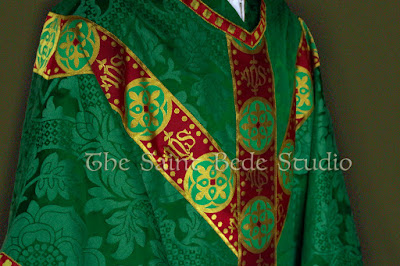In May of 2016 we heard that the tired subject of a "female diaconate" had been raised again, but this time - most disappointingly - by the Bishop of Rome who, in an "impromptu" remark during a meeting with Religious gathered in Rome, claimed that the history of deaconesses in the Early Church is "obscure". In August 2016, the Vatican Bulletin announced the formation of a Commission to study this, which the Pope has decided upon "after intense prayer and mature reflection".
*
The history of deaconesses in the Early Church is only obscure to those who either have not studied the issue, or to those who are determined to force such an innovation upon the Church. The Commission did meet and did not support the introduction of a female diaconate based upon the practice of the Early Church. That was in 2018. But then in 2019, the agitators were at it again and as has become notoriously obvious, the promoters of this innovation will not accept "no" as the answer.
 |
Giotto's 13th century depiction
of Saint Stephen the protomartyr
and deacon. |
The history of deaconesses in the early Church was the focus of a definitive study published in 1982 by the distinguished French liturgiologist,
Monsignor Aime-Georges Martimort. Ignatius Press published a translation of this wonderful work in 1986
Deaconesses : An Historical Study, which is still in
print. I urge you to obtain this book and read it (it assumes a working knowledge of Greek and Latin). It also appears to be available to be read
online.
But, above all is to be noted the deliberations of a previous Commission of the Holy See into this very subject,
published only 14 years ago and which may be read in full
here.
Deaconesses DID exist in the Early Church but they WERE NOT female deacons. Their ministry was narrowly defined, completely distinct from the ministry of the deacon and DID NOT include any liturgical role at the altar, where, according to Apostolic Tradition, no woman set foot. This is not what present-day advocates of deaconesses are seeking. They are seeking the feminisation of the Church's Orders and a ministry at the altar. This is not Tradition, it is innovation.This week past, motu proprio, the Bishop of Rome has made another change to a discipline of Apostolic origin. The argument that the Offices of Lector and Acolyte can be considered in distinction from the Orders of Deacon and Priest is not a Catholic approach, and represents a rupture with Tradition. What this will create for the Church we cannot be certain, but we do have a clue, being what has happened within the Anglican Communion over the past 40 years.
What separates the Orders of the Roman and the Eastern Churches from the ministries of Protestant denominations is Apostolic Tradition. We compromise that link to our great peril. One of the insights of the Second Vatican Council was to emphasise that the laity has roles and responsibilities which complement and yet are distinct from Ministry at the altar. We could start with the spreading of the Gospel in this age of Unbelief. Yet here we are almost 60 years later, still talking about why it is "urgent" that lay men and women minister at the altar.
-------------------------------------------------
* These are the actual words of the Vatican Bulletin and presumably are not intended to be ironic.










